
EB-2023-0654 | Updated Jan. 2024
A Guide for Identifying Pigweed Species Commonly Found in Maryland
This hand-held guide provides information on how to identify and differentiate common pigweed species in Maryland including: Palmer amaranth, Spiny amaranth, waterhemp, and redroot/smooth pigweed.
You have two options: you can either get a hard copy or access it here online (see content below). The hard copies are available for pickup at your local county Extension office, and they're completely free of charge. So, whichever method you choose, you'll be able to identify pigweed species with ease.
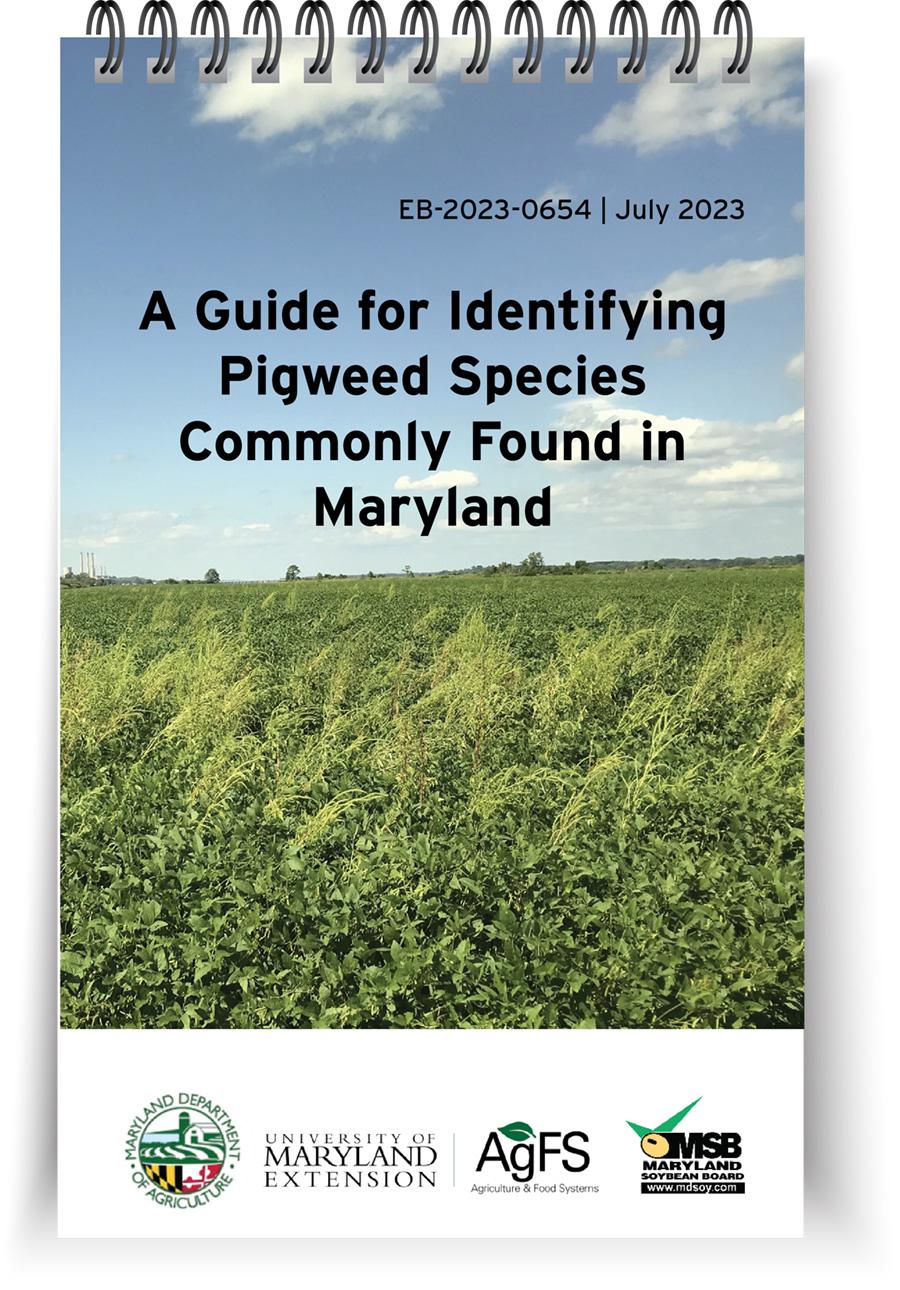
Palmer amaranth
(Amaranthus palmeri)
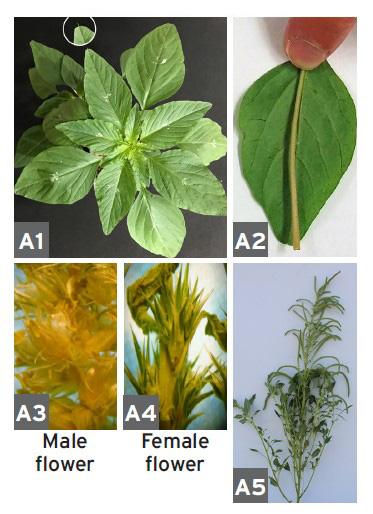
Palmer amaranth stems are smooth (hairless) and can be green, red, or red and green striped in color.
Palmer amaranth leaves are diamond-shaped, lack hairs on the surface, and sometimes contain a white or purple watermark. A single, stubby hair, often found in the notch at the leaf tip, may be used to help differentiate this plant from waterhemp (Photo A1). Leaf petioles of older leaves are as long or longer than leaf blades (A2).
Male (A3) and female (A4) Palmer amaranth flowers are produced on separate plants. The terminal flower spikes can be 2-3 ft. or more in length (A5). Male flowers can appear yellow due to the presence of pollen and are soft to the touch, while female flowers contain sharp bracts located in the leaf axils.
Spiny amaranth
(Amaranthus spinosus)
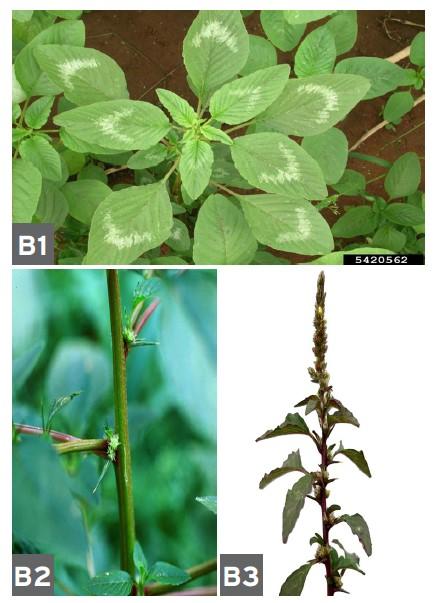
Spiny amaranth stems are smooth (hairless) and can be green, red, or red and green striped in color.
Spiny amaranth leaves are egg- to diamond-shaped, lack hairs on the surface, and sometimes contain a white or purple watermark (Photo B1). A spine (0.2-0.4 in.) will be present at the base of the leaf (B2). This species may have longer leaf petioles like Palmer amaranth.
Male and female spiny amaranth flowers are produced on the same plant (B3). These terminal flower spikes are typically 2-8 in. in length. Male flowers are found at the terminal spike and female flowers are found at the leaf axils.
Waterhemp
(Amaranthus tuberculatus)
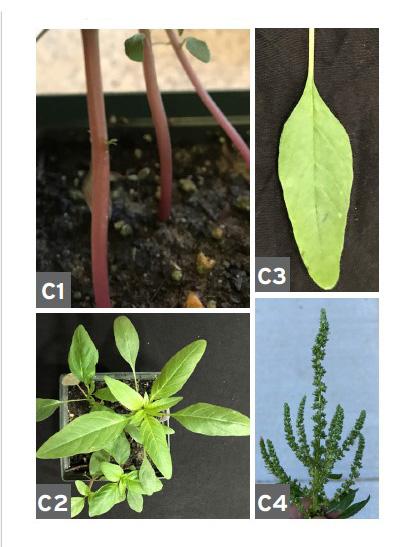
Waterhemp stems are smooth (hairless) and can be green, red, or red and green striped in color (Photo C1).
Waterhemp leaves are long and linear, lack hairs on the surface, and have a waxy appearance (C2). However, unlike Palmer amaranth, leaf petioles are shorter than the leaf blades (C3).
Male and female waterhemp flowers are produced on separate plants. These terminal flower spikes can be 1-2 ft. or more in length. Female flowers do not contain sharp bracts and clusters are more widely spaced compared to those of Palmer amaranth (C4).
Redroot Pigweed & Smooth Pigweed
(Amaranthus retroflexus) & (Amaranthus hybridus)
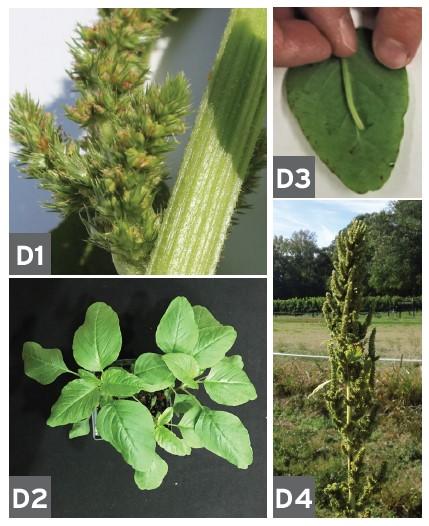
Both redroot and smooth pigweed stems contain hairs (Photo D1).
Redroot and smooth pigweed leaves are egg- to diamond-shaped, with wavy margins, and may or may not contain hairs on the surface (D2). Redroot pigweed leaves may have a white or purple watermark. The undersides of redroot pigweed leaves may be hairy. However, unlike Palmer amaranth, leaf petioles are shorter than the leaf blades (D3).
Male and female redroot and smooth pigweed flowers are produced on the same plant. These terminal flower spikes are typically 2-8 in. in length. Redroot pigweed flowers are thicker and more compact than smooth pigweed (D4).

Photo Credits
- Kurt Vollmer, University of Maryland: A1, A2, A3, A4, B3, C1, C2, C3, D2, D3, D4
- Ben Beale, University of Maryland: A5, D1
- Forest and Kim Starr, Starr Environmental, Bugwood.org: B1
- John D. Byrd, Mississippi State University, Bugwood.org: B2
- Lynn Sosnoskie, Cornell University: C4

KURT VOLLMER
kvollmer@umd.edu
BEN BEALE
bbeale@umd.edu
This publication, A Guide for Identifying Pigweed Species Commonly Found in Maryland (EB-2023-0654), is a part of a collection produced by the University of Maryland Extension within the College of Agriculture and Natural Resources.
The information presented has met UME peer-review standards, including internal and external technical review. For help accessing this or any UME publication contact: itaccessibility@umd.edu
For more information on this and other topics, visit the University of Maryland Extension website at extension.umd.edu
University programs, activities, and facilities are available to all without regard to race, color, sex, gender identity or expression, sexual orientation, marital status, age, national origin, political affiliation, physical or mental disability, religion, protected veteran status, genetic information, personal appearance, or any other legally protected class.